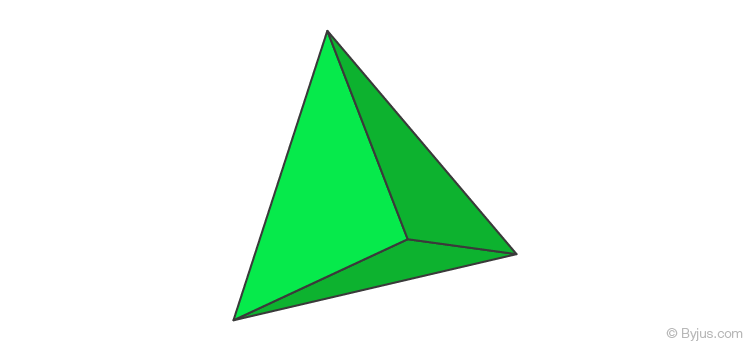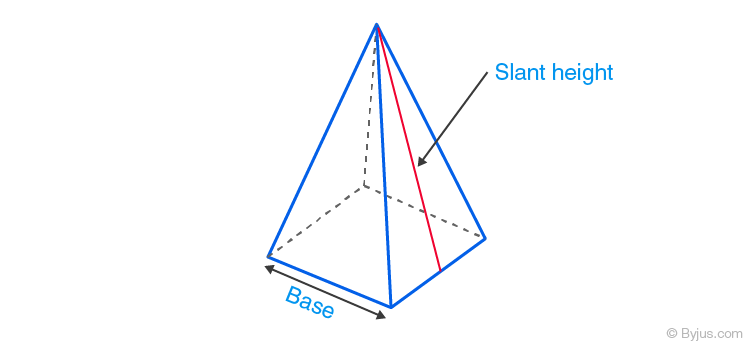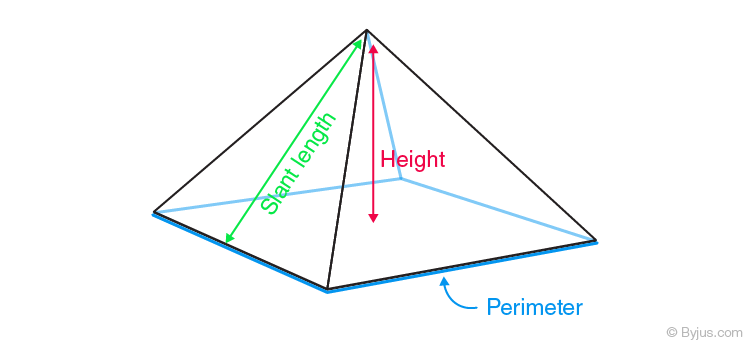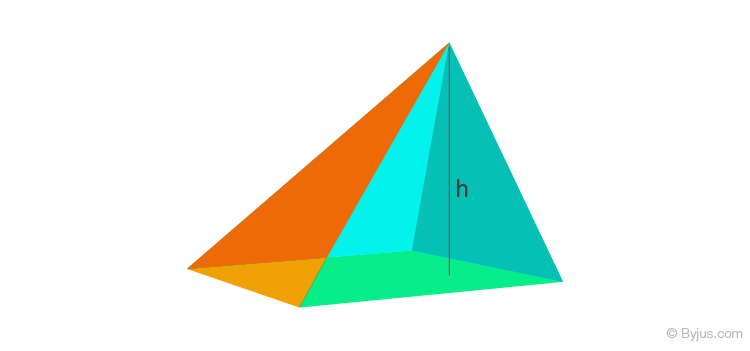Pyramid
A pyramid is defined as a three-dimensional structure encompassing a polygon as its base. You must have heard about The Great Pyramid of Giza, which is structured in the same concept. Every corner of this structure is linked to a single apex which makes it appear as a distinct shape. In this article, we are going to discuss what is a pyramid shape, different types of the pyramid with formulas and many solved examples.
Table of Contents:
- Pyramid Shape
- Types of Pyramid
- Right Vs Oblique Pyramid
- Regular Vs Irregular Pyramid
- Pyramid Formula
- Examples
- FAQs
Pyramid Shape
A pyramid is a three-dimensional shape. A pyramid has a polygonal base and flat triangular faces, which join at a common point called the apex. A pyramid is formed by connecting the bases to an apex. Each edge of the base is connected to the apex, and forms the triangular face, called the lateral face. If a pyramid has an n-sided base, then it has n+1 faces, n+1 vertices, and 2n edges.
Types Of Pyramids
Based on the shape of the base, the pyramid is classified into different types. Now, let us discuss the different types of pyramid shape one by one.
Triangular Pyramid
If the base of the pyramid is in a triangular shape (base with 3 sides), then the pyramid is called a triangular pyramid. As the triangle has 3 sides, then the triangular pyramid has the following properties:
No. of Faces = (3+1) = 4
No.of Vertices: (3+1) = 4
No. of Edges: 2(3) = 6

Square Pyramid
If the base of the pyramid is in the shape of a square (base with 4 sides), then it is called a square pyramid. As the square has 4 sides, then the square pyramid has the following properties:
No. of Faces: (4+1) = 5
No.of Vertices: (4+1)= 5
No. of Edges: 2(4) = 8

Pentagonal Pyramid
If the base of the pyramid is in the shape of a pentagon (base with 5 sides), then it is called a pentagonal pyramid. As the pentagon has 5 sides, then the pentagonal pyramid has the following properties:
No. of Faces: (5+1)=6
No.of Vertices: (5+1)=6
No. of Edges: 2(5)= 10

Right Pyramid Vs Oblique Pyramid
Right Pyramid:
The apex of this pyramid is exactly over the middle of the base, hence named as Right Pyramid.

Oblique Pyramid
The apex of this pyramid is not exactly over the middle of its base and named as Oblique Pyramid.
Regular vs Irregular Pyramid
To distinguish between regular and irregular Pyramid, you need to consider the shape of the base. If the base of a polygon is regular, it is labelled as Regular Pyramid, else it is considered as Irregular Pyramid. The figure given below illustrates the regular pyramid and an irregular pyramid.

Regular Irregular
Pyramid Formulas
The standard formula to find the surface area and the volume of the pyramid are given as follows:
The total surface area of a pyramid is the sum of the base area and half the product of the base perimeter and the slant height.
Thus,
The Total Surface Area of Pyramid = (½)Pl +B square units
Where,
“P” is the perimeter of the base
“l” is the slant height
“B” is the base area.
The general form to find the volume of the pyramid is one-third of the base area and the height of the pyramid.
Thus,
The volume of the pyramid = (⅓)×(Base Area)×(Height) Cubic units.
Solved Examples on Pyramid
Example 1:
Find the volume of the square pyramid, if its base area is 56 cm2 and its height is 9 cm.
Solution:
Given:
The base area of the square pyramid = 56 cm2
Height = 9 cm
Thus, the volume of the square pyramid = (⅓)(Base area)(Height) cubic units
Now, substitute the values in the formula, we get
The volume of a square pyramid = (⅓)(56)(9)
V = (56)(3)
V= 168 cm3
Hence, the volume of the square pyramid is 168 cm3.
Example 2:
Find the total surface area of the square pyramid if each side of the base measures 16 cm, and the slant height is 17 cm, and the altitude is 15 cm.
Solution:
Given:
As the base is a square, the perimeter of the base is 4 times 16 cm
P = 4(16)
P = 64 cm
The area of the base = a2
B = 162 = 256 cm2
We know, that the total surface area of the square pyramid is (½)Pl +B square units
Substituting the values in the given formula, we get
The total surface area of the square pyramid = [(½)(64)(17)] + (256)
TSA = 544 + 256
TSA = 800 cm2
Hence, the total surface area of the square pyramid is 800 cm2.
Keep visiting us and download BYJU’S – The Learning App to continue learning more maths concepts in an engaging and effective way.
Frequently Asked Questions on Pyramid
What is the pyramid?
A pyramid is a three-dimensional shape, with a polygonal base and flat triangular faces, which join at a common point called the apex.
What are the different types of the pyramid?
Based on the shape of the base of the pyramid, the pyramid is classified as a triangular pyramid, square pyramid, pentagonal pyramid, and so on.
Explain the right and oblique pyramid?
If the apex of the pyramid is directly above the centre of the base, it is called the right pyramid. Otherwise, the pyramid is called the oblique pyramid.
Explain the regular and irregular pyramid?
If the base of the pyramid is a regular polygon, the pyramid is a regular pyramid. Otherwise, it is called an irregular pyramid.
What is the general formula to find the volume of a pyramid?
The volume of a pyramid is one-third of the product of the base area and the height of the pyramid.

